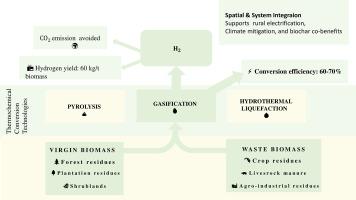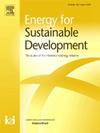肯尼亚生物质绿色制氢:地理空间原料评估和分散式能源系统集成
IF 4.9
2区 工程技术
Q2 ENERGY & FUELS
引用次数: 0
摘要
绿色氢越来越被认为是全球脱碳的重要能源载体。撒哈拉以南非洲拥有丰富的生物质资源,可以支持分散式氢系统;然而,空间明确的评估仍然有限。本研究对肯尼亚47个县的林业废弃物、作物废弃物和牲畜粪便进行了地理空间评估。利用土地覆盖和生产力数据集估算生物量可用性。利用基于产量、效率、原料相容性、成本和技术成熟度的决策矩阵,对三种生物质制氢途径(气化、热解和发酵)进行了比较。气化成为肯尼亚最合适的选择,实现每吨生物质约60 kg H₂和60 - 70%的转化效率,因此被选中进行详细建模。氢气产量通过化学计量气化模型估计,而桑基流程图用于追踪质量和能量平衡。情景分析考虑了技术最大限度和现实利用潜力。农田和森林残余物被认为是比灌木地质量更高的原料。在技术极限条件下,氢气生产潜力可达40万吨/年。到2035年,20%的适度利用率预计将达到每年7万吨。环境效益包括通过生物炭应用和化石燃料替代抵消高达90万吨二氧化碳的排放。总体而言,肯尼亚的生物质资源可以维持分散的氢途径,从而推进能源转型和农村发展目标。以地理空间为目标的原料测绘为新兴经济体的政策、基础设施规划和气候协同效益整合提供了可复制的框架。本文章由计算机程序翻译,如有差异,请以英文原文为准。

Green hydrogen production from biomass in Kenya: Geospatial feedstock assessment and decentralized energy system integration
Green hydrogen is increasingly recognized as a critical energy carrier for global decarbonization. Sub-Saharan Africa possesses abundant biomass resources that could support decentralized hydrogen systems; however, spatially explicit assessments remain limited. This study conducts a geospatial evaluation of forestry residues, crop wastes, and livestock manure across Kenya's 47 counties. Biomass availability was estimated using land cover and productivity datasets. Three biomass-to‑hydrogen pathways—gasification, pyrolysis, and fermentation—were compared using a decision matrix based on yield, efficiency, feedstock compatibility, cost, and technology readiness. Gasification emerged as the most suitable option for Kenya, achieving ~60 kg H₂ per tonne of biomass and 60–70 % conversion efficiency, and was therefore selected for detailed modeling. Hydrogen yields were estimated through a stoichiometric gasification model, while Sankey flow diagrams were used to trace mass and energy balances. Scenario analysis considered both technical maximum and realistic utilization potentials. Croplands and forest residues were identified as higher-quality feedstocks than shrublands. Under technical maximum conditions, hydrogen production potential reaches ~400,000 t per year. A moderate 20 % utilization scenario projects ~70,000 t annually by 2035. Environmental co-benefits include up to 0.9 MtCO₂e in emission offsets via biochar application and fossil fuel substitution. Overall, Kenya's biomass resources can sustain decentralized hydrogen pathways that advance both energy transition and rural development goals. Geospatially targeted feedstock mapping provides a replicable framework for policy, infrastructure planning, and climate co-benefit integration in emerging economies.
求助全文
通过发布文献求助,成功后即可免费获取论文全文。
去求助
来源期刊

Energy for Sustainable Development
ENERGY & FUELS-ENERGY & FUELS
CiteScore
8.10
自引率
9.10%
发文量
187
审稿时长
6-12 weeks
期刊介绍:
Published on behalf of the International Energy Initiative, Energy for Sustainable Development is the journal for decision makers, managers, consultants, policy makers, planners and researchers in both government and non-government organizations. It publishes original research and reviews about energy in developing countries, sustainable development, energy resources, technologies, policies and interactions.
 求助内容:
求助内容: 应助结果提醒方式:
应助结果提醒方式:


